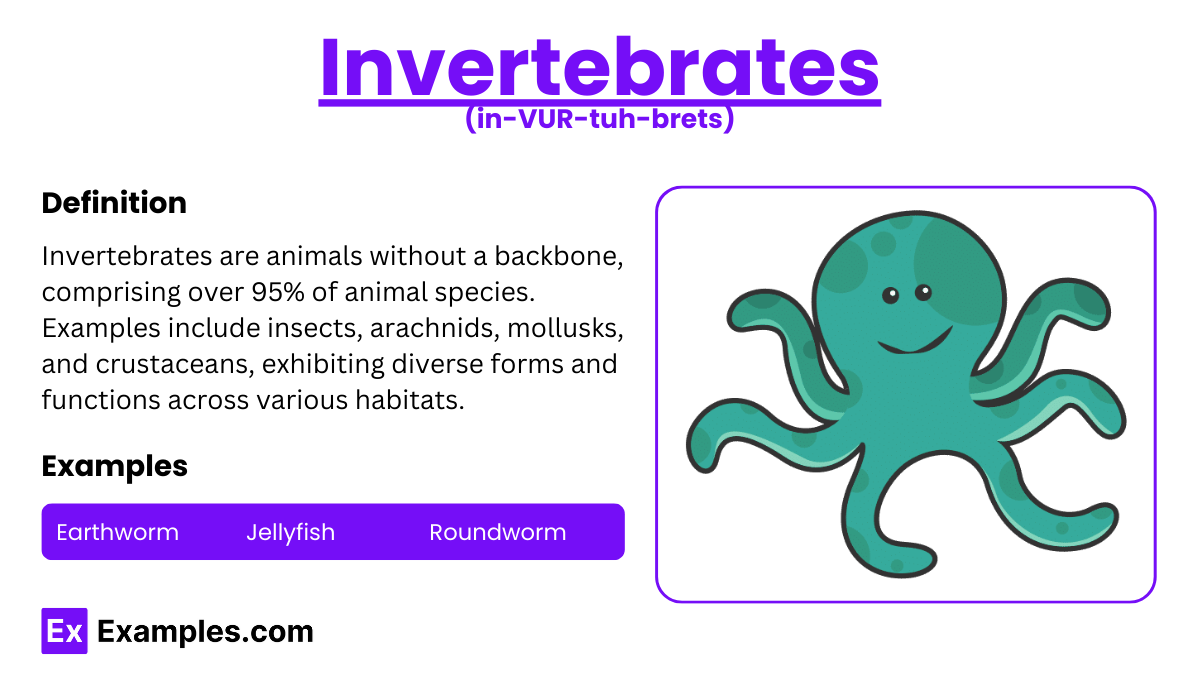Which of the following is a characteristic feature of invertebrates?
Backbone
Exoskeleton
Warm-blooded
Lungs


Invertebrates are cold-blooded animals that lack a backbone, encompassing a diverse range of species such as insects, arachnids, mollusks, and crustaceans. They constitute over 97% of all animal species on Earth. These organisms are found in various habitats, from deep oceans to tropical rainforests. As cold-blooded creatures, invertebrates rely on external sources to regulate their body temperature, adapting to their environment’s thermal conditions. Their evolutionary success showcases immense adaptability and diversity.
An invertebrate is an animal without a backbone. These cold-blooded creatures include a vast array of species such as insects, arachnids, mollusks, and crustaceans. Invertebrates make up over 97% of all animal species and are found in diverse habitats worldwide.

| Aspect | Invertebrates | Vertebrates |
|---|---|---|
| Backbone | Lack a backbone | Have a backbone (vertebral column) |
| Examples | Insects, mollusks, worms | Mammals, birds, fish, reptiles, amphibians |
| Body Structure | Generally simpler body plans | More complex body structures |
| Exoskeleton | Many have an exoskeleton (e.g., insects) | Typically have an internal skeleton |
| Diversity | Over 97% of animal species | Less diverse, fewer species |
| Size Range | Usually smaller | Often larger |
| Nervous System | Less complex nervous system | Highly developed nervous system |
| Reproduction | Mostly external fertilization | Mostly internal fertilization |
| Habitat | Found in almost every habitat on Earth | Occupy diverse but fewer habitats |
| Ecological Roles | Pollinators, decomposers, soil aerators | Predators, prey, ecosystem regulators |
Over 95% of animal species are invertebrates.
Insects, spiders, worms, and jellyfish are common examples.
Invertebrates reproduce through various methods including sexual and asexual reproduction.
Invertebrates inhabit diverse environments including oceans, forests, deserts, and freshwater.
Yes, invertebrates have a nervous system, though it varies in complexity.
Some invertebrates have sensory systems that can detect harmful stimuli.
Invertebrates breathe through structures like gills, tracheae, or their skin.
Many invertebrates have an open circulatory system, while some have a closed system.
Invertebrates have diverse diets including plants, animals, and detritus.
Invertebrates play crucial roles in ecosystems, such as pollination and decomposition.
Text prompt
Add Tone
10 Examples of Public speaking
20 Examples of Gas lighting
Which of the following is a characteristic feature of invertebrates?
Backbone
Exoskeleton
Warm-blooded
Lungs
Which group of invertebrates is known for having a radial symmetry?
Mollusks
Arthropods
Cnidarians
Annelids
What type of circulatory system is found in most invertebrates?
Open circulatory system
Closed circulatory system
Lymphatic system
Respiratory system
Which of the following invertebrate groups is primarily aquatic?
Annelids
Arthropods
Echinoderms
All of the above
What is the primary function of the cnidocytes found in cnidarians?
Movement
Digestion
Defense and capturing prey
Respiration
Which of the following invertebrate phyla is characterized by having a soft body and often a hard shell?
Arthropoda
Mollusca
Echinodermata
Porifera
What is the main purpose of the siphon in cephalopods?
Locomotion
Digestion
Reproduction
Respiration
Which type of invertebrate is known for its segmented body plan?
Echinoderms
Cnidarians
Annelids
Porifera
What is the primary feeding method of sponges?
Predation
Filter feeding
Herbivory
Scavenging
Which group of invertebrates includes animals with jointed legs and an exoskeleton?
Mollusca
Echinodermata
Arthropoda
Cnidaria
Before you leave, take our quick quiz to enhance your learning!

